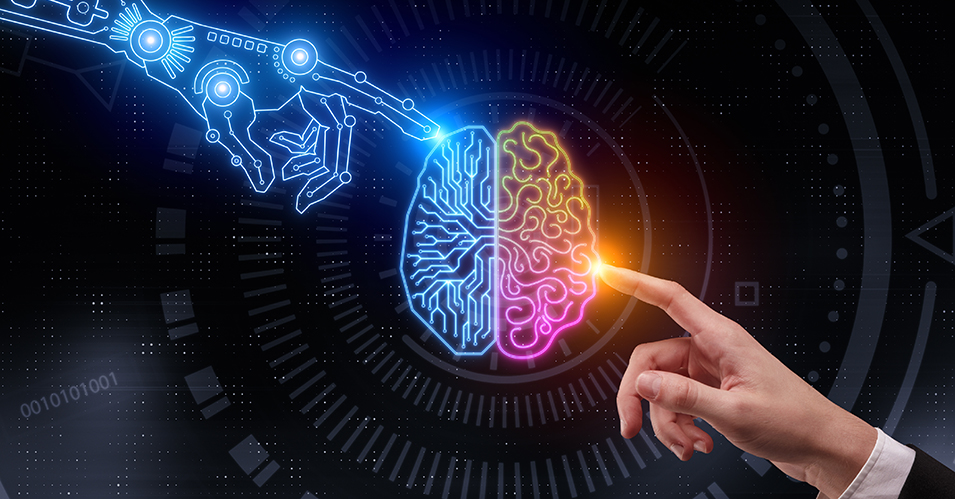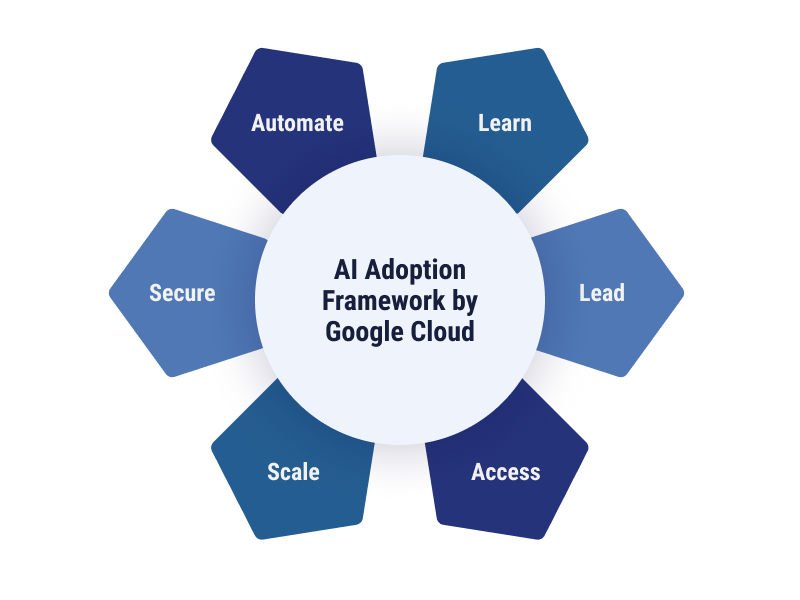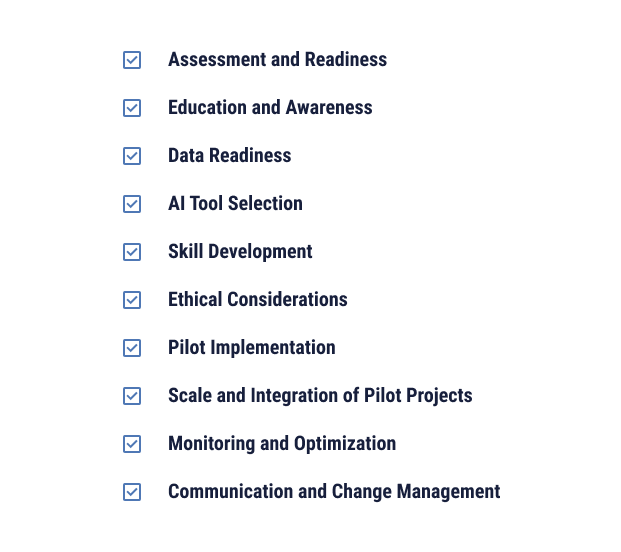
Artificial intelligence (AI) is poised and ready to revolutionize organizations. The technology can be used to improve efficiency, develop new services, gain insights into your business operations, and more. However, this is hard to accomplish without a proper AI adoption framework.
Here’s what you need to know before starting your AI adoption journey.
What is an AI Adoption Framework?
An AI adoption framework is an outline of an approach to integrating artificial intelligence into business operations. Major cloud providers, including AWS and Microsoft Azure, have AI and machine learning (ML) guidance within their Cloud Adoption Frameworks, but businesses may also develop their own, more specific plans to add AI into their processes.
The Importance of Using an AI Adoption Framework
The AI market in 2023 is currently valued at $150.2 billion and is set to reach $1.3 trillion by 2030. Many short-term and long-term developments are projected to contribute to this total, including generative AI for content creation, edge AI for decentralized processing, and explainable AI that improves transparency for AI models. Using an AI adoption framework can help businesses understand:
- What current and emerging technologies will be valuable to help reach certain objectives
- Best practices and what architectural components can facilitate successful implementation
How to Evaluate AI Adoption Maturity
Even with the current and future projected growth of AI, the AI adoption rate for companies has not changed as much as we might expect. According to a McKinsey report, approximately one-third of companies are using AI in more than one function in 2023. This number is fairly consistent with 2021. So, what makes companies more mature in their AI journeys?
Technology
Companies embracing AI are also more likely to be high-performing AI organizations according to the 2023 McKinsey Global State of AI Survey. In fact, these companies are five times more likely to adopt AI, and they say that more than 20 percent of their budgets are spent on AI. Companies that aren’t seen as high performers appear to have difficulty with the fundamentals of AI, impeding their ability to adopt the technology.
Industry
The nature of the business is also likely to make a difference. The use of generative AI, for example, is most common in the technology sector, followed by financial services. Adoption and use in the consumer goods/retail sector is least likely, with 26% of respondents saying they’ve had no exposure to generative AI tools.
Practices and Policies
Mature AI adoption is more likely to be proactive than reactive. Leadership teams that embrace AI tend to have organizational structures in place, with outlined policies and governance pertaining to AI. This helps champion AI and create important guardrails.
In-House Skills
Some organizations may find that they already have in-house talent that is poised and ready to adopt AI. However, it is far more common that employees will need to be reskilled to advance AI adoption maturity for the business. The McKinsey Survey also states that approximately 40% of respondents expect that 20% or more of their in-house workforce will be reskilled to aid in their AI journeys. This will take time and may not even fully address the skills gap a business might experience, depending on the current in-house skills available.
Best Practices for Building an Effective AI Adoption Framework
To begin building an effective AI adoption framework for your business, you may want to study pre-existing adoption frameworks and decide how to apply them to your business. The Google Cloud AI adoption framework is a good place to start and includes the following themes:

- Learn: Start by assessing the current skills in your organization and figure out what you might need to do to boost those skills. This can include training, augmenting with external IT staff, and hiring for new roles.
- Lead: To effectively adopt AI, leadership needs to be on board. Evaluate the structure of your teams and how much agency the data scientists have to apply AI/ML to the business in relevant use cases.
- Access: Data management is an important part of implementing AI, and data scientists need to be able to access, view, and share data and machine learning artifacts to enable AI in your organization. Dataset accessibility can’t be a hindrance; it needs to be a helper.
- Scale: As workloads get larger, cloud-native ML services need to scale with them. Provisioning and capacity need to be part of the conversation to enable AI effectively.
- Secure: New technologies bring new risks. ML services and data need to be protected from bad actors and unauthorized use. Determine the necessary security controls and what may need to be in place for everyone in the organization to trust the use of AI.
- Automate: One of the major benefits of AI is having the ability to automate repetitive business processes. Not only should your organization think about setting up pipelines, but you also need to consider how to ensure the pipelines are reliable and truly efficient.
How to Plan Out Your AI Adoption
In basic terms, companies can plan out their AI adoption by understanding what’s possible with AI/ML technology and working backward. Instead of adopting technology for the sake of technology, it’s important to identify business outcomes and what the organization hopes to achieve over months or years.

Assessment and Readiness
Assess the culture, skills, and infrastructure you currently have, and figure out what is needed for successful adoption. From there, you can better pinpoint which capabilities you need to have in place to achieve the transformation necessary for AI adoption. This might include conversations with different members of leadership, surveys, audits of current processes, and so on.
Education and Awareness
One of the most important steps in adopting AI is getting all levels of the organization on board. Take the time to educate key stakeholders and staff on the importance of adding AI to your business processes and promote AI literacy with training, lunch and learns, and Q&A sessions.
Data Readiness
Implementing AI at your business also means you’ll need to be able to handle big data. Assess your current data quality and consider investing in the infrastructure necessary to process, analyze, and store big data.
AI Tool Selection
Not all AI tools are created equal, and different tools will be appropriate depending on your business objectives, industry, skill set, and internal resources. Take a multi-dimensional approach to researching and exploring AI technology and tools.
Skill Development
Unless you are part of a larger business, it’s likely that you have AI and tech-related skills gaps that will need to be closed before you can build an AI framework. By identifying these gaps, you can figure out your next step, whether that’s hiring more people, bringing in outside help, or dedicating time to upskilling your current employees.
Ethical Considerations
As AI has become more prevalent, ethical considerations have also emerged. While you’re developing an AI adoption framework, don’t forget to define what responsible AI means to you. It may include some or all of Microsoft Azure’s principles of fairness, reliability and safety, privacy and security, inclusiveness, transparency, and accountability. For AI to be empowering, safe, and fair, employ and frequently refer to an ethical framework.
Pilot Implementation
The initial implementation of AI is the most important one, because its success can dictate the success of future initiatives. Choose one or two specific projects that are aligned with key business priorities for your initial implementation. From there, work on iteratively implementing AI solutions.
Scale and Integration of Pilot Projects
Once the pilot project takes off, it’s time to scale. Find opportunities to integrate AI solutions with your existing processes, applications, and systems. As you grow, you’ll also want to consider infrastructure that can handle and scale complex workloads, such as high-density colocation.
Monitoring and Optimization
Don’t forget that implementing AI in your business is not a one-time project that should not be revisited. Establish key performance indicators (KPIs) that can be used to measure the impact of AI implementations, and use these KPIs to refine applications over time. This ensures continued success with AI projects.
Communication and Change Management
Smooth internal adoption doesn’t happen overnight, but it can be aided greatly by establishing effective change management practices. Develop an internal communications plan that keeps stakeholders informed of the status of current and future projects, and detail how you will make and sustain organization-wide changes. Some people will be enthusiastic early adopters, while others will be slow to change. Keep this under consideration as you create your change management and communication plans.
Get the Resources You Need for Successful AI Adoption
Sometimes, it’s hard to see what successful AI adoption can look like at your organization from the inside. Bringing in outside expertise can help illuminate the path to future AI adoption. TierPoint’s public cloud consulting capabilities can provide the perspective businesses need to build a successful cloud framework that includes guidance on adopting AI. TierPoint can also power AI through our high-density colocation services, allowing you to scale and grow without any structural roadblocks.
Interested in learning more about the impact a well-researched AI implementation can have? Read our whitepaper to understand how AI and ML can transform your business.

